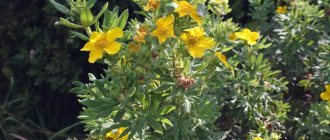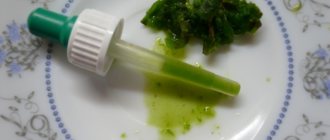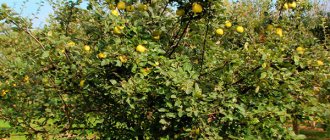Planting Kuril tea (five-leaf tea)
The distance between plants is 60 – 80 cm. Planting depth is 50 – 60 cm. The root system is superficial, but individual roots penetrate to a depth of 80 cm. The root collar is at ground level.
It is recommended to plant in open sunny places. It stops blooming in the shade. Cinquefoil does not tolerate soil compaction and is demanding on soil fertility.
The soil consists of leaf soil, humus, sand (2:2:1). Tolerates high carbonate content and can grow on calcareous soils. Drainage is required, with a 20 cm layer of broken brick or river pebbles.
Non-varietal Cinquefoils are propagated by seeds. Kuril tea seeds are sown in the spring without prior preparation and lightly mulched with sifted leaf soil. Sifted leaf soil is also used as a substrate. The shoots of Kuril tea are very small and delicate. The height of one-year-old seedlings is 3-5 cm, two-year-old seedlings are 10-12 cm.
Varietal plants of Kuril tea are best propagated vegetatively: by green and lignified cuttings, layering, root suckers, and dividing bushes. When cuttings are taken in June, in the year of rooting, a plant grows from the cuttings 30 - 35 cm high, the length of the root system is 23 -27 cm. Such Kuril tea plants are already suitable for planting in a permanent place in the garden. The rooting rate of Kuril tea is very high and there will be no problems with vegetative propagation (cuttings, offspring, etc.).
Caring for Kuril tea
Caring for Kuril tea consists of feeding, watering, loosening and mulching.
Complete mineral fertilizer for Kuril tea is applied in the spring and during planting at the rate of 100 - 150 g per square meter. m. Before flowering, phosphorus and potassium fertilizers are given.
Kuril tea can go without watering for a long time. Feels bad in dry air. In hot and dry summers, it is recommended to water Kuril tea plants 3 times a season and spray them in the evening so as not to damage the flowers. The watering rate is 10 - 12 liters per plant.
It is necessary to loosen the soil around Kuril tea to a depth of 5–10 cm while compacting the soil and removing weeds.
Kuril tea must be mulched with 3–5 cm of soil after planting in order to keep the soil from drying out longer. You can trim the shoots of Kuril tea once every 3-4 years in the second half of April by 8-10 cm to make the bush compact. In the fall, if necessary, Kuril tea bushes are also molded; in September, the shoots are cut to 1/3 of their length.
Application
Kuril tea can be used to prepare many health promoting products that are used as adjuvant therapy. Before use, you should consult your doctor.
tea drink
How to cook: pour boiling water over the teapot, then add 2 tsp. tea, pour boiling water over it and drain the water immediately. This will “awaken” the brew, and therefore the taste of the drink. Afterwards, pour boiling water over the raw materials again, cover the kettle with a towel and leave for 15 minutes.
How to take: replace everyday drinks with Kuril tea, you can drink it without restrictions.
Decoction for throat diseases
How to cook: 5 tbsp. l. dry raw materials, pour boiling water (0.5 l) and place in a water bath for half an hour. Then strain.
How to take: rinse your mouth and throat with warm broth every time after eating, but no more than 5-6 times a day. Course: until complete recovery.
Tea against poisoning
How to cook: 1 tbsp. l. Brew a glass of boiling water, place the mixture in a water bath for 15-20 minutes. Filter.
How to take: drink a small sip of the prepared tea every 2 hours at the first symptoms of poisoning. Course: 2-3 days.
Tea as a diuretic and choleretic agent
How to cook: 1 tbsp. l. pour boiling water (250 ml) of Kuril tea. Leave to infuse for 40 minutes and strain.
How to take: 3 times a day, 2-3 tbsp. l. before meals.
Cinquefoil for douching
How to cook: 2 tbsp. l. fill the raw materials with hot water (0.5 l). Leave for half an hour and strain.
How to use: strictly following your doctor's instructions. Douching with a decoction of Kuril tea perfectly helps with various gynecological diseases.
Tea bath against nervous disorders
How to make: 10 tbsp. l. tea, pour 1 liter of boiling water, put on low heat and boil for 30 minutes. Then leave to infuse for another 1 hour and strain.
How to use: add the prepared infusion to a bath of water and take for 20-30 minutes. Course: 10-14 days.
It is worth noting that, unlike most medicinal plants, Kuril tea has a surprisingly pleasant taste. Therefore, green or black tea can be easily replaced with cinquefoil.
Preparing Kuril tea for winter
Decorative forms of Kuril tea are mostly winter-hardy; only in severe winters do the ends of annual shoots freeze. They are cut off. At the same time, Kuril tea plants do not lose their decorative properties. With age and thanks to fertilizing, the frost resistance of Kuril tea increases.
Midsummer is a hot time for harvesting strawberries (garden strawberries). It would seem that after picking these delicious berries, you can forget about caring for strawberry bushes until the next season, that is, until spring. However, this opinion is erroneous, since already this year, after fruiting, flower buds of next year’s harvest begin to form on garden strawberries. Therefore, after picking the berries, strawberries should be properly cared for. We recommend studying how to water and what to feed strawberries after fruiting in July, August and September in our article.
Plant characteristics
Bush tea is an upright, highly branched shrub of the Rosaceae family. There are about ten species of plants. The leaves are compound, with five or seven elongated hairy leaflets. Due to the shape of its leaves, Kuril is popularly called cinquefoil. Another name for shrubby cinquefoil is Dasiphora, which translates as “bearing thick hairs.” Numerous branches are delicately hairy when young, but when mature they are covered with exfoliating bark of a brownish-gray or reddish-brown hue. The flowers are located on the tops of this year's shoots, yellow in color, solitary or collected in small clusters. The petals are bright yellow, round in shape. There are about 30 stamens in the center of the flowers, giving them a fluffy appearance.
- Kuril tea grows slowly in nature, reaching maturity by 20-40 years. The height of an adult cinquefoil shrub is 80-120 cm, at which time the plant begins flowering, which lasts from July to August.
- Cinquefoil is a bisexual plant, characterized by the single blooming of flowers of different sexual types. Each flower blooms for about 6-48 hours, the duration varies depending on weather conditions.
- The fruits of the bush are produced from August to September; they look like small dry nuts, very numerous.
Caring for strawberries in July after fruiting
After harvesting, caring for strawberries includes the following procedures:
- regular watering;
- weeding;
- loosening and hilling;
- feeding;
- removal of mustaches and dried leaves.
Weeding and loosening
After fruiting, the strawberry beds should first be cleared of weeds. If the soil was covered with mulch, it should be removed, as pests and diseases can accumulate in old straw or sawdust.
To allow air to reach the roots, the soil around the bushes must be loosened. This should be done carefully to avoid damaging the roots.
After weeding and loosening, the strawberries are watered and hilled, covering the new growing roots with soil. In this case, it is necessary to ensure that the heart of the plant is not covered with soil.
Watering strawberries in July
Many gardeners are interested in whether it is necessary to water strawberries in July . The watering procedure must be carried out. The frequency and abundance of watering depends on the weather. In dry and warm weather, strawberries are watered at least once every 5-7 days in July. If it's cool outside and it's raining, there's no need to water the strawberry beds.
Attention! The soil should not be allowed to dry out. If there is no precipitation in warm weather, use approximately two buckets of water for each square meter of bed.
Trimming tendrils and leaves
About 2-3 days after harvesting, remove old dried leaves from the strawberry bushes, as well as those that have red, tan or white spots. These are dying leaves that take away nutrition from the plant. They should be removed using pruning shears or sharp scissors.
Along with the leaves, unnecessary strawberry mustaches are also removed. For propagation, you can leave the most productive and powerful rosette, which is located immediately next to the mother plant.
Attention! When removing leaves and tendrils, be careful not to damage the hearts and new leaves.
Old foliage is often infected with various diseases and pests, so be sure to remove it.
How to feed strawberries after fruiting
In July, after trimming leaves and tendrils on strawberry bushes, the plants need nitrogen, which will stimulate the growth of new foliage. Can choose:
- Nitramfoska or nitrophoska . Any fertilizer is diluted at the rate of 1-2 tbsp. spoons per 10 liters of water. If you only use nitrophoska, add a glass of wood ash, which contains many trace elements, to the solution.
- Ammofoska . The fertilizer contains a large number of microelements. You can prepare a solution from it (for 10 liters of water - a matchbox of fertilizing) or use it dry. Dry fertilizer is scattered around strawberry bushes at the rate of 20 grams (matchbox) per 1 square meter. meter of planting, after which the beds are watered.
In the second half of July - early August, mullein or bird droppings will be a good fertilizer for strawberries. They cannot be added fresh, as they can burn the roots of the plants. It is recommended to use solutions:
- chicken manure is diluted 1:15 and the bushes are watered with it so that the solution does not get on the foliage;
- Mullein is diluted 1:10, left for 24 hours and used for its intended purpose.
Chicken droppings and mullein can be enriched with mineral fertilizers by adding wood ash to the solution (per 10 liters - 1 liter of ash).
Attention! Strawberries do not like chlorine, so potassium chloride and other fertilizers containing this element cannot be applied to strawberries. Otherwise, the plants will grow and bear fruit worse.
Should I prune cinquefoil in the fall?
Pruning is a must for caring for cinquefoil. If it is neglected, the bush loses its attractiveness and shape, the lower branches become bare. In addition, timely pruning guarantees long and abundant flowering. The question of “whether it is necessary to prune cinquefoil for the winter” is something every gardener decides for himself. Experts say that this is not contraindicated in principle and will save time in the spring - you will not need to spend it on forming the crown.
Autumn pruning is carried out before the onset of cold weather and before snow falls. To do this, you need a powerful pruner, since the old branches have a decent thickness for a shrub. Dry, broken shoots are removed completely, the rest - no more than half the length (and ideally 1/3). Garden varnish is used as an antiseptic for treating cuts. However, it is recommended to do such pruning in the spring, before the leaves appear. This is especially true for the north of temperate latitudes: an unthinned shrub will retain more snow, which will allow it to overwinter more comfortably and eternally receive more moisture.
Caring for strawberries in August
Watering
The last month of summer is often hot, so be sure to water your strawberry beds about twice a week. If the foliage begins to dry out and wilt, the plants do not have enough moisture.
Around mid-August, the soil around the strawberries can be covered with mulch. First, the beds are watered abundantly (per 1 sq. m - 15 liters of water). You can use humus as mulch, spreading it in a layer of 2-3 cm. Such mulch will become a good top dressing and at the same time protect the soil from drying out. Strawberries can be watered less often.
Tillage of soil and bushes
Do not forget to promptly remove weeds from strawberry beds, which not only prevent strawberries from growing, but also take away nutrition from the soil.
If the leaves on your strawberries are still drying out and turning yellow, continue trimming them. Each bush should have at least 3-4 healthy young leaves.
Trim the newly appeared mustaches, and transplant those left for propagation to a new bed.
What to feed strawberries in August
In the last month of summer, there is no need for foliage to actively grow, so fertilizers containing large amounts of nitrogen are not used.
If you didn't feed your strawberries with mullein or bird droppings in July, do it in August. Dilute bird droppings 1:20, and mullein – 1:10. One watering can (10 liters) will be enough to feed 12 bushes.
In August, it is recommended to feed strawberries with potassium and phosphorus. These elements are part of Fasco fertilizer. Fertilizers Agricola, Ryazanochka, Rubin are produced especially for strawberries, which are used according to the instructions supplied with them.
After watering and fertilizing, do not forget to carefully loosen and hill up the strawberry bushes.
Treatment against pests and diseases
It is imperative to carry out preventive treatment of strawberries against various pests and diseases. To do this, water the soil with a weak solution of manganese and spray the foliage.
Strawberry leaves should be inspected regularly:
- Brown spots on leaves may be a sign of viral diseases. Treat the plantings with Bordeaux mixture.
- Damage to young leaves often indicates that there is a mite in the strawberry bed. Use Actellik, collodide sulfur solution or Titovia Jet to destroy it.
- If the berries rot before harvest , the plants may be infected with a fungus. When all the berries have been collected, the foliage should be sprayed with a solution of copper oxychloride.
Caring for strawberries in September
In the first month of autumn, strawberries are prepared for wintering. If after harvesting the strawberries were properly cared for, flowers will still form on the plants. They should be picked off, since there will be no more berries, and the flowering will take away the strength of the plant. You also need to trim off new tendrils and withered foliage.
Do I need to water strawberries in the fall?
If the weather is dry, strawberry beds are watered 1-2 times a month in September. About 10 liters of water are consumed for every square meter. Since autumn is already cool, frequent watering can lead to the development of fungal diseases. Therefore, it is better to water strawberries rarely, but abundantly.
Before covering the plantings in October, water-recharging irrigation is carried out.
What to feed strawberries in September
To survive the cold winter, plants need strength, for which they are fed with phosphorus fertilizers. You can use superphosphate (50 grams) and wood ash (1 glass), which are diluted in a bucket of water.
Plants can be “insulated” before winter using cow manure or chicken manure:
- cow manure is diluted in water (1:10), wood ash (1 cup) is added and one and a half liters is poured under each plant;
- chicken droppings are diluted in water 1:15, after which each bush is fed with a liter of solution.
Mulching
In September, the soil in the strawberry bed is covered with mulch (if this was not done in August). Dry crushed grass, pine needles, straw, leaf humus, and sawdust can be used as mulch. The mulch layer should be about 5 cm.
You can cover the soil under the plants with spandboard.
Shelter for the winter
Covering strawberries for the winter with straw and spruce branches
Only weakened plants that have not received the necessary nutrition need additional shelter for the winter. Cover the bushes at a temperature of about -3 degrees and dry weather. In this case, the covering material will remain dry. For shelter, you can use dry potato tops, leaves, spruce branches, straw, and raspberry branches.
When to cover strawberries for the winter depends on the climate of the region. It may be October or November, when light frosts set in.
If all measures were taken when caring for strawberries after fruiting in July, August and September, the next year the strawberries will thank their owners with a good harvest.
This plant is popularly called shrubby cinquefoil. It has been known for a very long time; even in ancient times, folk healers of the East used Kuril tea as one of the important components for preparing many medicinal infusions and decoctions. Today, gardeners grow it on their plots not only to obtain delicious medicinal tea, but also to decorate flower beds and rock gardens. Potentilla flowers are beautiful, the bushes are spreading, depending on the variety, they reach a height of up to one and a half meters. Planting and caring for a plant in open ground is not difficult even for novice gardeners.
Description of popular varieties and varieties of cinquefoil
Many centuries have passed since this plant was first discovered and people learned about its beauty and healing properties. Thanks to the work of breeders, new varieties and hybrids of Kuril tea have appeared. In the photo you will see all the variety of these varieties: multi-colored shades of petals, the height of the bushes varies from low-growing plants to large specimens, the leaves also have different sizes and tones of color.
Experienced gardeners and landscape designers skillfully combine the decorative qualities of cinquefoil with other plants in the garden, achieving harmony with the surrounding nature and the emotional effect that the sight of a flower garden with a five-leaf plant produces on people.
- Kuril tea (ordinary) is a shrub up to 1 meter high, has many branches with a dense spherical crown with a diameter of up to one and a half meters, flower petals are yellow, up to 3 cm in diameter, single or racemose. Flowering begins in June and ends in August. In the wild it grows on rocky mountain slopes; in the garden it takes root well on alpine hills.
Kuril tea (regular)
- Abbotswood is a bush of medium height, up to 1 meter, snow-white flowers, a small crown, a little more than one meter in diameter. It blooms all summer and part of autumn, until October.
Abbotswood
- Pretty Poly is a low-growing variety (up to 60 cm), early flowering (the first buds bloom in May), medium-sized soft pink flowers, spreading branches, compact, small crown.
Pretty Poly
- Princess is an early flowering variety, up to 80 cm high, pink flowers, dense crown, almost even on top.
Princess
- Goldteppich has large, bright yellow flowers, the shrub itself almost spreads along the ground, reaching a height of 50 to 70 cm, a long-blooming variety (May - October).
Goldteppich
Planting cinquefoil in open ground and caring for the plant
Gardeners who have been growing Kuril tea for years know many of the nuances of planting this plant, the dependence of its growth on the location, the nature of the soil, and the time of planting. Beginning flower growers should be guided by the description of each variety indicated on the packaging of planting material, but some general agrotechnical requirements must be met for all types, these include the following:
- the landing site should be sufficiently well lit;
- the soil is recommended to be light and fertilized;
- The plant should be planted in the morning or evening;
- to prepare the soil you need to use a substrate of fertile soil, sand and humus;
- It is necessary to leave enough space between plants, depending on the variety;
- the size of the holes should exceed the size of the root ball with soil.
When to fertilize
It is not at all difficult to care for such a plant, like all similar plantings, cinquefoil requires little:
- Regular watering, especially in hot weather.
- Fertilizing in spring, during active flowering and in autumn. Usually mineral fertilizers containing phosphorus and potassium are used, and nitrogen components are added in the autumn.
- Pruning is carried out constantly throughout the growing season.
Pruning regularly
In open ground, cinquefoil takes root perfectly if the listed growing conditions are observed and the plant is regularly cared for (watering + fertilizer).
Plant propagation methods
Kuril tea is propagated in different ways: by seeds, cuttings, layering or dividing the bush. We will briefly describe them, starting with the most difficult.
Propagation by seeds
You need to collect seeds yourself, from existing plants, as they ripen, in September or October. In early spring, seeds are sown to obtain seedlings in special containers with a fertile substrate; after the first true leaf appears, they are planted in separate pots, and with the arrival of warm days, the seedlings are moved to open ground.
Cuttings
The cuttings may be green or already lignified. Young green branches are cut into pieces 9-12 cm long, leaving 2 leaf buds, upper and lower. The lower part of the cutting is dug in, and half of the leaf is removed from the upper part. Planting should be done within 2 days so that the seedling cuttings do not dry out. Then you should water and lightly mulch the soil. You can dig 3 plants into one hole and then separate them.
Kuril tea stalk
Lignified cuttings are harvested in the fall and stored all winter in a cool place; in early spring they are transplanted into fertilized soil in open ground.
Reproduction by dividing the bush
This is one of the easiest ways to propagate Kuril tea. An adult bush with a powerful root system and many branches is divided into parts, 3-4 branches each, and planted at a distance from each other, observing all agrotechnical requirements.
Attention! Such division is possible only for bushes aged 4 to 6 years, when the plant acquires a sufficient number of root shoots and upper shoots.
How to deal with diseases and pests of Kuril tea
Cinquefoil is not very susceptible to disease, but sometimes, if regular preventive treatment of the plant is not carried out, it can be affected by powdery mildew, rust or leaf spot. In garden plots, city parks and flower beds at the beginning of the season, that is, in the spring, plants are sprayed with chemicals against diseases and pests: a solution of copper sulfate or a fungicide.
Advice. Young bushes that have contracted powdery mildew in the first year of planting must be removed from the site, and nearby plants must be treated with the above-mentioned agents.
Kuril tea is rarely attacked by pests, but if this happens, preparations containing substances with a pungent odor will help scare them off: ammonia solution, garlic tinctures, decoctions of tomato tops.
Kuril tea - a medicinal plant
Kuril tea is grown in household plots not only as a medicinal plant, but also its natural beauty is used in combination with all kinds of plants.
Kuril tea looks really colorful, gives a lot of pleasure, pleases the eye with its grace, and at the same time with its pristine beauty.
Shrubs for the garden: video
The most common plant in landscaping is Kuril bush tea (Pentaphylloides fruticosa). This is a low, up to 1.5 m tall, shrub with a beautiful dense crown and small feathery pubescent leaves.
It is distinguished by long-lasting (from June to mid-autumn) flowering. Simple yellow flowers, similar to cinquefoil flowers, look impressive. There are varieties with larger flowers of different colors. But they are less winter-hardy. Kuril tea is undemanding to soil, drought-resistant, and winter-hardy. Does not require special pruning, but easily tolerates haircuts and rejuvenation “on the stump”. It is convenient to propagate by summer cuttings.
There are many varieties of Kuril tea with yellow flowers. Everyone is good. But if you are looking for variety, pay attention to the varieties Abbotswood with white flowers, Princess with pink flowers and Red Ace with red flowers.
What regular Kuril tea looks like, look at the photo below:
When to fertilize
It is not at all difficult to care for such a plant, like all similar plantings, cinquefoil requires little:
- Regular watering, especially in hot weather.
- Fertilizing in spring, during active flowering and in autumn. Usually mineral fertilizers containing phosphorus and potassium are used, and nitrogen components are added in the autumn.
- Pruning is carried out constantly throughout the growing season.
Pruning regularly
In open ground, cinquefoil takes root perfectly if the listed growing conditions are observed and the plant is regularly cared for (watering + fertilizer).
Description and use of Kuril tea
Kuril tea (shrub cinquefoil) is a specimen well known for its medicinal as well as decorative qualities. People also use other names - “cinquefoil goose”, “moguchka”.
If we talk about the description of Kuril tea, we can highlight several characteristic features of this representative of the plant world:
- It is an erect, highly branched shrub belonging to the Rosaceae family. The height depends on the variety and place of growth.
- The leaves have a complex shape (each element consists of 5-7 miniature leaves) and are covered with fluffy hairs.
- The flowers of the most common variety are deep yellow. In their center there are about 3 dozen stamens, which give splendor to the inflorescences. There are also samples with pink, white, and scarlet buds. Flowering is long lasting, lasting almost all summer.
- The bushes bear fruit with small nuts.
Kuril tea is a shrub that is actively used in the decoration of personal plots. Landscape designers use it as monoplantings or as part of intricate group compositions. It is effective in low living fences, rock gardens, and looks advantageous both against the background of a green lawn and on stones.
Cinquefoil does not differ much in taste from ordinary tea, so an aromatic, tonic drink is often prepared from it. It perfectly quenches thirst and activates physical and mental activity.
Growing Kuril tea is important for alternative medicine - it boasts a rich composition. The plant contains flavonoids, tannin, catechin, saponins. There is a whole range of useful microelements (Ca, Mg, K, Fe, etc.), vitamins C, P, as well as essential oils and resins. Indications for use may include:
- pathologies of the digestive organs - nutritional poisoning, dysentery, dysbacteriosis, constipation;
- gynecological, hematological diseases – uterine hemorrhages, anemia;
- metabolic disorders, endocrine diseases - diabetes, obesity;
- neurological and mental disorders – neurosis, insomnia, depression;
- dermatological pathologies – ulcers, ulcers;
- inflammatory processes of the oral cavity, throat - stomatitis, sore throat.
The immunostimulating activity of Kuril tea has been proven, so it is advisable to take it during epidemics of influenza and ARVI. Infusions, decoctions (for oral use), and lotions (for external use) are made from the plant.
Despite all the positive properties of this tea, not everyone can drink it and not always. Among the contraindications, it is worth mentioning infancy, pregnancy, allergies, serious kidney problems, hypotension, etc. Before use, you must consult with a herbalist, be sure to discuss with him acceptable treatment options, the possibility of using this or that variety.
Contraindications
Despite all the beneficial properties, Kuril tea has certain contraindications. It should not be taken in the following cases:
- individual intolerance, allergies;
- hypotension;
- chronic kidney disease;
- cholecystitis;
- urolithiasis disease;
- period of pregnancy and lactation;
- children's age up to 7 years.
Very rarely, side effects may occur - diarrhea, nausea, dizziness, fever, rash. In this case, cinquefoil-based products should not be taken.
Kuril tea is an amazing plant that will decorate the garden and relieve diseases. It has an incredible aroma and amazing taste. However, we should not forget that this is, first of all, a medicinal plant. If you plan to use it for medicinal purposes, be sure to consult your doctor. We told you how to prepare, when to collect raw materials and how to dry them. Take advantage of our tips and then drinks prepared with Kuril tea will become even healthier.
Varieties of Kuril tea: photos and descriptions of bushes
Many varieties of Kuril tea are cultivated, each of them has its own characteristics. Collectors, designers and gardening enthusiasts prefer the following samples:
Kuril tea “Snowbird”
Bushes 0.7 m high, with a crown diameter of 1 m. The leaves are pale green. The flowers are large (3-4 cm), white with a cream tint. Flowering begins in mid-summer and continues until September.
Kuril tea “Abbotswood”
Neat specimens up to 0.75 m high. Flowers are very decorative, numerous, snow-white. Blooms for a long time - from the second half of summer to early autumn.
Kuril tea “Pink Queen”
Height up to 0.8 m, diameter 1.5 m. Blooms from June to September. The color of the buds is all shades of pink. The plant is characterized by frost resistance.
Kuril tea “Tangerine”
A very beautiful, medium-sized bush. The inflorescences have a rich bronze-yellow color.
Kuril tea “Klondike”
Early flowering (May-August) bushes 1 m high, 1.3 m in diameter. Light green leaves bloom in early spring, which then become dark green. A very winter-hardy specimen.
Most of the varieties were bred in England, the Netherlands, and Ireland through complex selection.
After reading the description of Kuril tea, look at the photos of its varieties:
Methods of propagation of Kuril tea
In order for the plant to perform decorative functions and be a high-quality medicinal raw material, it is necessary to ensure that Kuril tea is grown and cared for in accordance with all the rules. Cultivation of cinquefoil involves several traditional methods. The simplest is cuttings. Gardeners like to use this method, because it does not involve fancy techniques and is suitable for large-scale propagation.
Two types of shoots are prepared - how to grow Kuril tea with their help is explained further:
- green cuttings - no more than 2 days should pass between cutting and planting. The length of the shoot with leaf nodes is from 9 to 12 cm. The lower leaves are eliminated, the upper ones are cut in half. Treatment with drugs that stimulate root formation is indicated. Plant the material in a prepared, drained substrate, under film or glass.
- lignified cuttings - mature, leafless shoots harvested in autumn, winter or spring are used. Cuttings tolerate long-term storage and transportation well. The length of the shoot is from 5 to 12 cm. Planted in a greenhouse.
It will be useful for beginner gardeners to know how to plant Kuril tea with seeds. They begin collecting grains in August-September and sow them in a greenhouse. Place the seeds in the soil superficially, without deepening, only sprinkling a little substrate on top. The emerged seedlings are protected from the bright sun and carefully hardened off. Seedlings are transferred to “free” soil only after 3 years.
Kuril tea can be propagated by layering - horizontal or vertical. In the spring, the shoot is pinched with wire at the very base, and shallow cuts are made for more successful rooting. The branch is bent to the soil, fixed with a metal bracket, sprinkled with soil, and hilled up.
Dividing mature bushes is another elementary and effective technology with which Kuril tea is grown. Planting in this way is allowed when there is access to an adult, 5-6-year-old bush. It is its root apparatus that is divided into several full sections and then planted in holes. As a result of the manipulation, from 2 to 6 new copies are obtained.
Planting bush Kuril tea
If we talk about the middle climatic zone of the country, then the optimal time for Kuril tea shrubs is to plant them in a permanent place in the 2nd half of April or in the fall. It is important to approach the choice of location responsibly. Cinquefoil prefers bright, sunny areas of the site and rich soil.
The dimensions of the planting ditch are 50x50x50 cm, the distance between the bushes is 60 cm. Limestone gravel can serve as drainage. The bottom of the pit is filled with humus, sand, and turf soil in a ratio of 2:1:2. It is allowed to add wood ash, lime, and mineral fertilizer. The best time of day is considered to be early morning or evening. The root collar of the plant is not buried excessively; it is left at the level of the edges of the trench.
Do I need to prune cinquefoil for the winter?
Cinquefoil is one of the most numerous representatives of the Rosaceae family. It grows in the northern hemisphere in Eurasia and America, preferring a temperate climate zone. In nature, the plant lives near water bodies, in coniferous forests, on mountain slopes, and in meadows. Its name is translated from Latin as power, strength. There are legends about the properties of the shrub. The beauty of cinquefoil has won the hearts of gardeners, which is why it is readily grown in garden plots for decoration and as hedges. How to plant it, how to care for it, whether it is necessary to trim the cinquefoil, what properties it has - the article talks about this.











